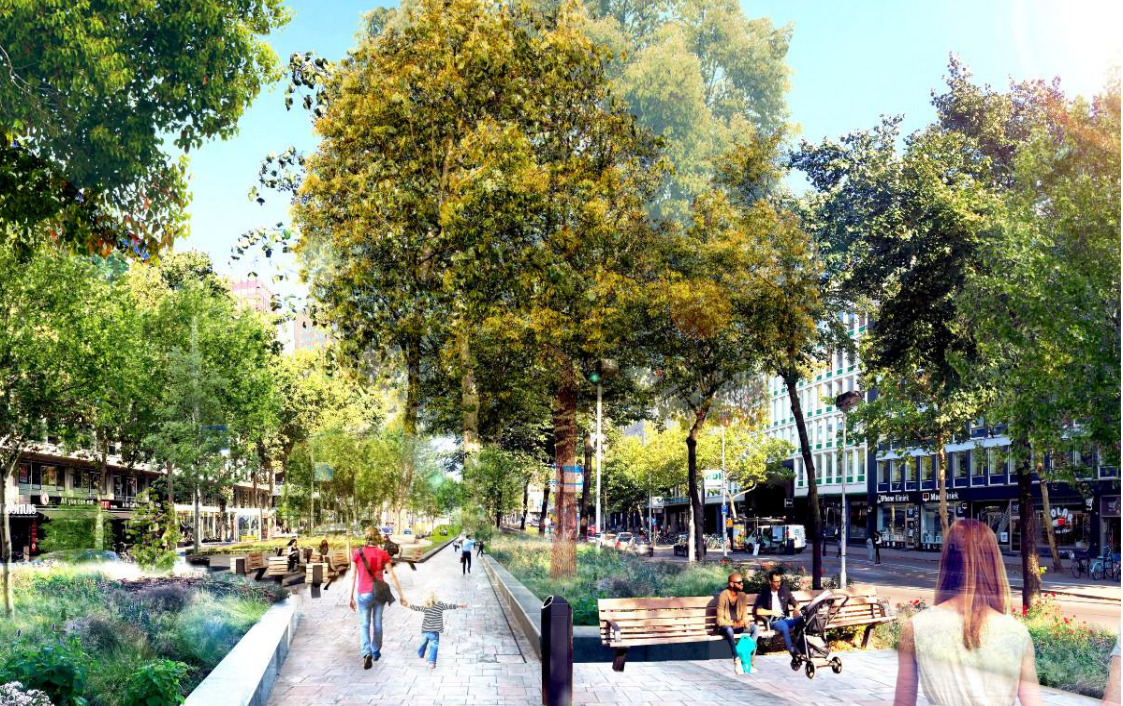
Photo: City of Rotterdam (Westblaak ‘green lung’ initiative,)
COVID-19 is shifting the focus from smart cities to resilient cities
26 October 2020
by Sarah Wray
The COVID-19 crisis has focused the minds of local governments on the need to build resilience into their recovery strategies.
While COVID-19 has knocked the world sideways, 2020 has also witnessed parallel and compounding crises, including social unrest through the Black Lives Matter protests; intense climate events with heatwaves, hurricanes and wildfires, and the unfurling economic shocks following the pandemic.
This perfect storm looks set to be a pivotal moment in changing attitudes to resilience, with a clear focus on learning lessons to strengthen communities against future shocks and stresses – whether economic, social or environmental.
“Having this constant, high level of shocks and stresses together has really brought home to people that you’ve got to bring that multiple benefit approach into the present,” says Lauren Sorkin, Executive Director at the Resilient Cities Network (RCN), which is the organisation that evolved out of the 100 Resilient Cities (100RC) network.
A refocus on resilience
One lesson that cities had already learned in terms of building resilience is the need to appoint leadership which can break down silos within local government. Chief Resilience Officers (CROs) are at the forefront of this. Launched and funded as part of the 100RC programme, one of the key roles for city CROs has been to communicate and collaborate across different departments. This is essential to build a coherent strategy which can help cities face up to the challenges posed by climate change, health crises or an economic downturn.
The ability to bring multiple strands together is where CROs excel because they “understand people in a different way and they understand the integration between the challenges that the city might face,” Sorkin says.
The advent of COVID-19 has seen CROs receive greater support in terms of funding, staff resources and proximity to the mayor. A survey by the Resilient Cities Network, run with Dalberg Advisors, found that 87 percent of Chief Resilience Officers are involved in their city’s COVID-19 response or recovery effort.
“When city leaders need to make decisions, they want to make sure that they are purposefully building for a resilient future and so they’re calling on their CROs for their advice and analysis,” Sorkin says.
Despite severe budget challenges globally, cities such as London and Tel Aviv, have set up dedicated resilience funds following COVID-19. Several cities have now pledged to recruit a CRO, including Austin, Texas, and a number of states in the US and regions elsewhere are developing legislation to create resilience officer roles or take on resilience responsibilities. The issue is going up the agenda in fast-growing cities in emerging markets too, as well as at the national policy level. India’s Ministry for Housing and Urban Affairs, for example, recently launched the Climate Smart Cities Assessment Framework, which aims to provide a clear roadmap for cities towards combating climate change.
From why to how
This elevation of resilience is not only at the policy level as with COVID, there has been a marked shift towards a more practical approach to deploying resilience measures.
As Arnoud Molenaar, Chief Resilience Officer, City of Rotterdam, explains: “We are entering a new phase. So far, we have been busy explaining what resilience is about and why it is important. Now, we are entering a phase that’s much more about the how.”
Rotterdam is one of the more mature cities when it comes to resilience. It created the Chief Resilience Officer role in 2014, broadening out the climate adaptation programme which had been in place since 2008. In 2016, Rotterdam launched its first documented resilience strategy. It also has, for the first time, assigned resilience formally as a responsibility of one of its vice-mayors and has appointed a cyber-resilience officer with a dedicated budget. Rotterdam is doubling down on its approach following COVID-19 and embedding resilience into all aspects of city planning.
“COVID is giving us new insights but also a new trigger to focus even harder than before on resilience,” says Molenaar.

His team recently began the process of updating the resilience strategy in light of the pandemic and other learnings over the last four years, and this work will also feed into the city’s mid- and long-term COVID recovery planning.
The 2016 strategy outlines seven qualities of resilience: reflectiveness, resourcefulness, robustness, redundancy, flexibility, inclusiveness and integrated. These are central to Rotterdam’s recovery plan and the first one in particular – being reflective — is now coming into play.
“If we really want to learn from the situation, then we have to organise on a structural basis, harvest the lessons learned, and harvest the vulnerabilities that have become clear because of COVID,” says Molenaar. “When we have a good mapping of this, then we can also focus on these new vulnerabilities. We have to learn from this crisis and make ourselves stronger to be better prepared for the next one.”
This is echoed by cities around the world which have pledged to address systemic inequity and prioritise sustainability in their recovery planning. Of 53 respondents from 47 different cities within the Resilient Cities Network that responded to the Dalberg survey, 79 percent said that enhancing social equity is a top priority for recovery.
Molenaar adds: “The challenge is raising awareness about not only coming out stronger from the COVID crisis but also that we are already in a crisis – we can apply the lessons from COVID to the economic crisis but also to the bigger wave, which is the climate crisis. It isn’t only coming; it’s already here.”
As part of its COVID-19 economic recovery plan, Rotterdam recently announced seven city projects (the ‘Big 7’), which aim to boost the economy and liveability, with a focus on green infrastructure and climate adaptation as well as creating jobs and attracting businesses. Other key initiatives which are now being accelerated in Rotterdam include the use of a ‘filter’ tool, which is a set of principles to help the city make decisions, with citizens, about which ideas or actions to prioritise.
The leading principle is that initiatives have to contribute to a more resilient society and economy. The city is working with Erasmus University to develop criteria that can be used to judge whether proposals contribute to the resilience goal.
Further efforts to embed resilience thinking throughout all levels of the municipality, rather than it being perceived as the role of the resilience team, include providing training on how to apply the city’s ‘Resilience Scan’ and apply it to specific projects. The scan provides a checklist to help people ensure they have taken into account possible shocks and stresses and considered resilience qualities within their plans. So far, this training has been mainly delivered to spatial planners but will be rolled out more widely.
Molenaar says: “If you think about flexibility in spatial planning related to climate change, you have to take into account a lot of uncertainty and it may be that within 30 or 40 years you have to adjust your plan – for higher-than-projected sea-level rise, for instance. It’s important not to make future adjustments impossible and that’s a kind of flexibility that’s not really common among spatial planners.”
Sorkin sees, too, that there is a growing push from cities for practical tools they can use in their recovery planning. In July, the Resilient Cities Network released its Toolkit for Resilient Recovery, developed collaboratively with city members.
“We’ve seen huge resilience and recovery funds earmarked. The toolkit aims to help cities to prioritise according to multiple challenges,” Sorkin says.
Within the network, cities are also collaborating to develop tools and frameworks in key areas including the circular economy, climate resilience, waste management and prevention of plastic pollution in the ocean.
Delivering the infrastructure to support resilience
Ramsey Green, Deputy Chief Administrative Officer for Infrastructure and Chief Resilience Officer, City of New Orleans, also notes the importance of a practical approach to resilience in light of COVID-19.
It is just over 15 years since Hurricane Katrina devastated New Orleans, killing more than 1,800 people and causing US$125 billion in damage. More recently, pre-pandemic, the city has faced everything from a large-scale cyber-attack to the partial collapse of a large hotel under construction, an exploding turbine at a water plant and countless severe storms. Then came COVID.
“I believe there is a direct relationship between infrastructure and resilience,” says Green. “When the resilience function of our government was started, it was very much a policy ideas shop. Vision is important in city government, especially in a place like New Orleans, but delivery is more important.”

Since New Orleans saw its first COVID diagnosis in mid-March, Green says the city has executed over US$300 million in infrastructure contracts alone. The city’s bid process has gone completely online and 95 percent of the professional non-field workforce shifted to working at home.
Green was appointed as Deputy Chief Administrative Officer for Infrastructure in 2018, following the election of Mayor LaToya Cantrell, and subsequently assumed the position of Chief Resilience Officer.
“A big reason I was hired is because the city was so behind in the delivery of infrastructure projects,” Green says.
He explained that when he began the role, almost US$1.8 billion in federal infrastructure funding which was provided for the City of New Orleans and the New Orleans Sewerage and Water Board following Hurricane Katrina was largely unspent, despite being approved in July 2016 and earmarked specifically for rebuilding streets, water lines and drainage.
Another US$300 million in Federal Emergency Management Agency (FEMA) hazard mitigation funds and US Department of Housing and Urban Development (HUD) funds for green infrastructure projects “sat languishing”. Co-ordination was also an issue, with the same roads often being dug up repeatedly for separate infrastructure projects due to a lack of holistic planning.
“We have aggressively focused our work on building up our in-house ability to honestly and effectively manage the deployment of these funds and the construction of these projects, vastly improving the infrastructure within our city while making a substantial impact on our local economy,” Green explains.
Projects underway and set to break ground by the first quarter of 2021 include the Gentilly area Blue & Green Corridors and Mirabeau Water Garden, which use natural systems to manage water and reduce flooding; St. Anthony Green Streets, where stormwater solutions are being retrofitted; and the St. Bernard Neighborhood Campus, which integrates green infrastructure and recreational improvements at a school and playground.
The Oak Park and St Roch FEMA hazard mitigation projects, which will store up to 30.7 million gallons of stormwater, have also been approved for construction funding.

Both the state of Louisiana and the City of New Orleans categorised construction as an essential service since the start of the pandemic.
“Construction is a big [way] that we’re mitigating ourselves against the impact of future significant, and even minor, storms – putting better drainage lines and green infrastructure in – so we’ve really accelerated those projects,” Green adds.
To date, US$2 million in bond funding has been allocated to the French Quarter pedestrianisation concepts for sidewalk repairs, for instance, and the construction of bicycle and pedestrian-focused infrastructure is also underway through the Moving New Orleans Bikes (MNOB) programme. Currently, the city is building 11 miles of cycling routes on the West Bank of the Mississippi River in the Algiers neighbourhood.
“We never stopped or slowed down,” says Green. “Despite the pandemic, it doesn’t mean that the city won’t flood; it doesn’t mean that the effects that our city faced prior to the pandemic go away so we have to continue to get the work done that we were doing before we got here.”
Another instance of this has been the launch of New Orleans’COVID-19 meal assistance programme, which was 75 percent funded by the Federal Emergency Management Agency (FEMA), with the rest covered by the city through Coronavirus Aid, Relief, and Economic Security (CARES) Act money. The initiative engaged local restaurants to prepare and deliver food to residents in need. Over 12,000 residents now receive up to two meals per day and the programme is set to continue for the foreseeable future.
Sorkin observes that food resilience programmes have been a key initiative during the pandemic.
“Whereas before [CROs] were looking at strengthening rooftop gardening to provide healthy food and cooling, now they are also thinking about food supply in terms of shoring up their city’s nutritional content, and in terms of people not having to travel very far [for food],” she says.
The meal assistance programme is also an example of the wide-ranging role of the CRO, with Green noting that the pandemic has seen him considering everything from large construction projects to children’s playgrounds and the impact of the pandemic on mental health and food insecurity.
“Every day I learn something that amends the way we do this work,” he adds.
Digital enablers
Digital initiatives are playing a key role in resilience, too, with cities seeing their digitalisation planning as a way of supporting and driving resilience. Like CROs, the Chief Information/Digital/Innovation Officer is a relatively new post in many cities and importantly it is also cross-departmental because breaking down data silos is the key to cities being able to improve decision-making – as has been shown during the pandemic.
The convergence of resilience and digital strategies is crucial to cities not only combatting climate change but also to tackling social and economic shocks. Edinburgh unveiled its digital strategy for the next three years earlier this month with an emphasis on how it can help meet the target of eradicating poverty in the city by 2030. It is the first UK city to set such a target and this dovetails with the city’s aim to be carbon-neutral by the same year. Meanwhile, Orlando shifted from the term smart city to ‘future-ready city’ with its first documented strategy, which is now open for final citizen feedback and prioritises equitable resilience.
While COVID has shown that cities must adopt a holistic approach to digitalisation and resilience planning, it is equally important that they have the means to implement this.
The argument to central government is that resilience not only protects cities from future shocks but actually provides an opportunity for them to assure a better economic future.
According to the Royal Institute of Chartered Surveyors, over the next few decades, commercial real estate developers are just as likely to base investment decisions on rising sea levels as on rising interest rates.
“We are being asked by clients more and more about the dynamics of risk and resilience in cities, rather than national economies”, agrees Jeremy Kelly, Director of Global Research at JLL, a global real estate services company.
The biggest mistake post-COVID would be for national and local governments to let budget shortfalls and short-term economic recovery mask the need to address long-standing crises such as climate change and equity. Chief Resilience and Digital Officers must work together to address multiple threats.
“Everyone’s going to be borrowing for stimulus or investment, and that is money that cities would have borrowed for climate action or [to address] the future of work,” says Lauren Sorkin of the Resilient Cities Network. “We have one shot to get at those multiple issues, and to recover and achieve climate resilience.”







